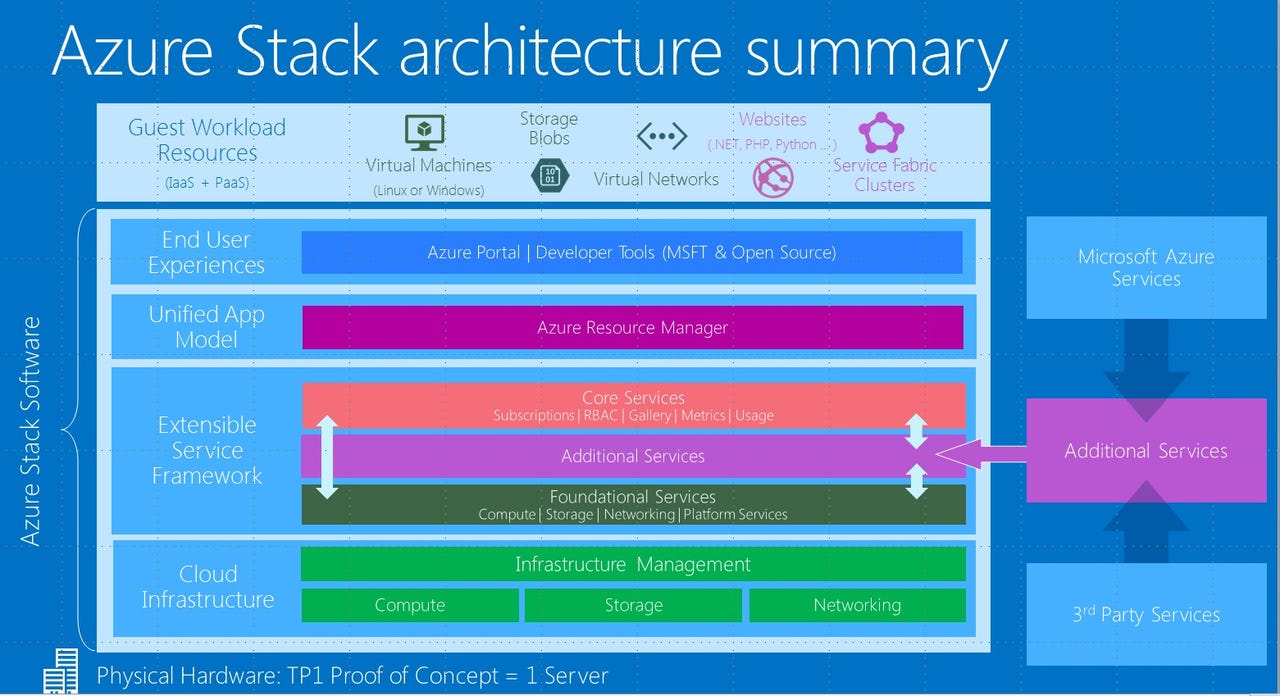Microsoft readies first technical preview of Azure Stack hybrid-cloud bundle

About six months later than originally anticipated, Microsoft is ready to make available the first public technical preview of Azure Stack, its customized cloud bundle.

Microsoft officials originally outlined the company's plans for Azure Stack last May at the Ignite conference and said to expect a preview of the technology later last summer.
On January 29, this Friday, Microsoft will make that promised technical preview available. Microsoft is aiming to make Azure Stack generally available in the fourth calendar quarter of 2016, officials said.
What is Azure Stack? Check out the lovely architectural diagram from Microsoft in this post above to get the big picture.
Read this...
In short, Azure Stack is a "stack" of technologies that customers and/or hosting partners can run in their own datacenters. It's meant to encourage customers who can't or won't move to the public cloud to still get some of the technological and operational cloud-computing benefits with an on-premises product.
"This is different from Amazon with AWS saying 'our datacenter is for everyone,'" said Partner Director of Program Management Ryan O'Hara.
"Azure Stack is an extension of Azure," O'Hara said. "The experiences are the same as in Azure, the application programming interfaces are the same, so artifacts, like Azure Resource Manager, are portable across (the two)."
The first technical preview of Azure Stack will include a host operating system, plus a number of Windows and Linux virtual machines that can run various services. The host operating system is not some version of Windows Server; instead, it is a number of Windows Server technologies customized to run on approved hardware components selected by the customer.
Microsoft plans to offer Azure Stack a list of qualified components from which to choose to build their Azure Stack systems. Microsoft published the hardware requirements for running Azure Stack Technical Preview 1 late last year. Moving forward, Microsoft also plans to work with server vendors to ultimately build these systems as preconfigured offerings, O'Hara said.
Microsoft's overarching goal with Azure Stack is to provide users with a standardized architecture that is common to both the public and private cloud. Azure Stack and Azure will include the same portal, unified application model and common dev-ops tools. The application model is based on Azure Resource Manager, and the shared tools include Visual Studio and PowerShell.
Between now and the fourth quarter of the year, Microsoft plans to release a series of technical previews of Azure Stack that will add more services and content, including operating system images and Azure Resource Manager templates. Like Azure, Azure Stack will allow users to host "cloud-native" (platform-as-a-service) applications, as well as traditional applications via infrastructure-as-a-service workloads.
Users can sign up now to be notified of availability of the Azure Stack technical preview.
Update (January 31): In case it wasn't clear (and it wasn't, to me), he Azure Stack Technical preview 1 requires Windows Server 2016 Datacenter Edition Technical Preview 4 to work. I've asked Microsoft whether this also will be a requirement for the final version of the product. No word back so far.
Update (February 4): A Microsoft spokesperson sent me some additional information a couple of days ago regarding requirements for Azure Stack as it advances beyond preview.
Microsoft officials wanted to stress that Azure Stack deploys "on the metal" and is not a bundle of software that is deployed on top of Windows Server and System Center, as was the case with Windows Azure Pack. Azure Stack contains some Windows Server technologies at its core, but had to be deployed on Windows Server 2016 TP4 because some of those technologies at the core of Azure Stack weren't ready when the preview was released.
Will Windows Server be a requirement for the final version of the product? Officials ar not saying at this point. All they will say is:
"As we get closer to GA (general availability), this will become much more integrated and seamless to customers. For example the compute, storage and networking technologies that we've innovated on in Windows Server 2016 will be inside Azure Stack, but you won't see them in the context of a Windows Server 2016 admin portal."